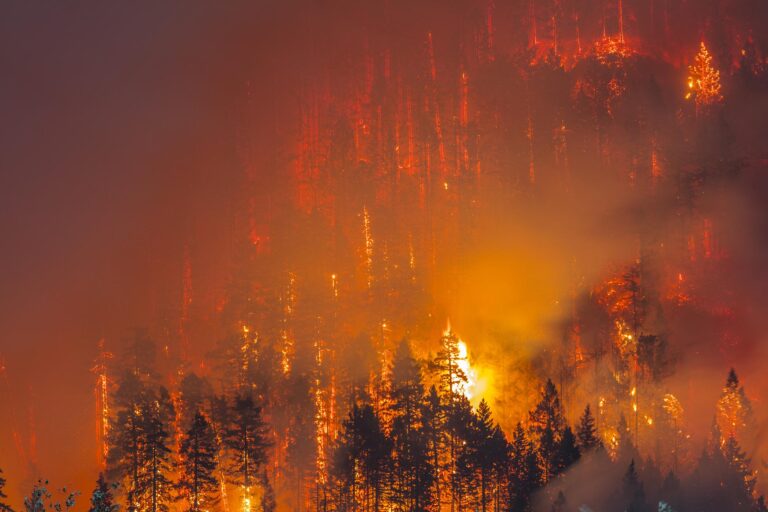Canada has already experienced a staggering escalation in wildfire activity this year, with the total area scorched by flames surpassing the amount typically burned over an entire year. According to recent data, the unprecedented scale of these wildfires has raised alarm among experts and officials, highlighting the growing impact of climate change and the urgent need for enhanced fire management strategies. This development marks a critical moment in Canada’s ongoing battle against increasingly severe and frequent wildfires, which have devastated vast swaths of forest and threatened communities across the country.
Canada Faces Unprecedented Wildfire Devastation as Burned Land Surpasses Annual Average
Canada is grappling with an intense wildfire season that has already scorched more land than the country typically sees in an entire year. Regions across British Columbia, Alberta, and the Northwest Territories have experienced massive blazes fueled by a combination of dry conditions, soaring temperatures, and persistent winds. Firefighters and emergency services remain stretched thin as evacuation orders multiply, threatening communities and disrupting thousands of lives.
Key factors driving the unprecedented wildfire activity include:
- Record-breaking heat waves causing extreme drought conditions
- Declining moisture levels in forests, creating tinderbox environments
- Strong, shifting winds accelerating fire spread
- Larger, more frequent lightning strikes igniting new blazes
| Province/Territory | Burned Area (hectares) | Typical Annual Average (hectares) |
|---|---|---|
| British Columbia | 1,250,000 | 900,000 |
| Alberta | 750,000 | 500,000 |
| Northwest Territories | 620,000 | 400,000 |
Government agencies and environmental experts warn that this trend could intensify, calling for increased investment in wildfire prevention, real-time monitoring technologies, and community preparedness programs. The devastating effects on ecosystems, air quality, and the economy underscore an urgent need for adaptive strategies in the face of a changing climate.
Experts Analyze Causes Behind Escalating Wildfire Intensity and Spread
Scientific consensus points to a complex interplay of environmental and human factors fueling the relentless surge in wildfire activity across Canada. Rising average temperatures have extended dry seasons, creating tinderbox conditions that allow fires to ignite and spread rapidly. Experts emphasize the role of prolonged droughts, increased lightning strikes, and the accumulation of dry vegetation as crucial contributors to the intensifying wildfire seasons. Additionally, changing wind patterns have been linked to unpredictable fire behavior, complicating containment efforts and extending the reach of these blazes.
Human influences compound the natural factors, with land-use changes and growing encroachment into forested areas increasing vulnerabilities. The following table summarizes the primary causes as identified in recent studies:
| Cause | Description | Impact on Wildfires |
|---|---|---|
| Climate Change | Warmer temperatures and altered precipitation | Extended dry seasons and more intense fires |
| Lightning Strikes | More frequent, natural ignition sources | Rapid fire starts, especially in remote areas |
| Drought Conditions | Reduced soil and vegetation moisture | Increased fuel availability |
| Human Activity | Land management and accidental ignitions | Higher fire incidence near communities |
With these factors converging, experts warn that wildfire management strategies must evolve. They advocate for a combination of advanced monitoring technologies, targeted controlled burns, and expanded community preparedness programs to stem the growing wildfire threat facing Canada.
Urgent Policy Shifts and Community Actions Needed to Mitigate Future Wildfire Risks
With wildfires in Canada having already consumed an area larger than the yearly average, immediate and bold policy reforms are imperative. Governments at all levels must prioritize updating forest management practices by integrating advanced fire detection technologies and increasing controlled burn programs. Investment in resilient infrastructure, such as fire-resistant building materials and improved evacuation routes, is critical to protect vulnerable communities. Additionally, climate adaptation strategies need to be embedded within national and regional policies to address the growing frequency and intensity of fire seasons fueled by rising temperatures and prolonged droughts.
Community engagement plays an equally vital role in wildfire risk reduction. Local populations should be empowered through education campaigns on fire-safe landscaping, emergency preparedness, and real-time communication networks. Collaborative approaches that involve Indigenous knowledge can enhance fire mitigation efforts, given their deep understanding of traditional land stewardship. Below is a snapshot of key action points for policymakers and communities:
- Implement widespread prescribed burns to reduce fuel load safely.
- Expand early warning systems using satellite data and AI prediction models.
- Enforce stricter land-use regulations in high-risk wildfire zones.
- Support community-led fire prevention programs tailored to local environments.
| Policy Area | Proposed Action | Expected Outcome |
|---|---|---|
| Forest Management | Expand controlled burns by 30% | Reduce wildfire fuel load |
| Infrastructure | Fire-resilient building codes | Lower structural damage |
| Community Engagement | Launch wildfire education programs | Increase public preparedness |
| Technology | Develop AI fire prediction tools | Enable faster response times |
Closing Remarks
As Canada confronts the escalating scale of its wildfire crisis, the implications extend beyond immediate destruction to long-term environmental and economic impacts. With more than a year’s worth of land already consumed by flames, authorities and communities face mounting challenges in mitigation, recovery, and climate adaptation. The situation underscores the urgent need for coordinated action and resilience planning as the country grapples with the growing threat posed by wildfires.




